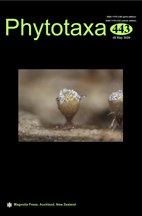Abstract
Phyllophorella was recently described from two localities on the central coast of Peru (12°S), based on the endemic species Phyllophora (Ph.) peruviana. The genus currently accommodates three species, Phyllophorella (P.) peruviana, P. humboldtiana and P. limaensis. Recent field surveys for Phyllophorella on the central coast of Peru led to the discovery of collections outside the originally reported ranges. Morphological, anatomical, and genetic characterization of the specimens confirms range extensions for P. peruviana to 9° S and 15° S, and P. humboldtiana to 12° S and 15° S. A combined phylogenetic analysis of rbcL and COI-5P gene sequences supports the taxonomic status of these two species and reasserts the genus as monophyletic. Anatomically, the two species differ in nemathecial structure. Phyllophorella peruviana displays dome-shaped and well-defined circular nemathecia, whereas in P. humboldtiana they are irregular and diffuse in form. Mature cystocarps were observed for the first time in Phyllophorella, in P. humboldtiana from Lima and Ica, Peru. Phyllophorella, as well as the other genera classified to the family Phyllophoraceae, have a procarpic sexual system, with a carpogonial branch of three cells; the cystocarp develops a thickened cortex, is immersed in the medulla, and lacks a pericarp and an ostiole. This study demonstrates that field work, together with morphological, developmental, and genetic analyses, are useful methods for improving our understanding of seaweed distributions and systematics.

